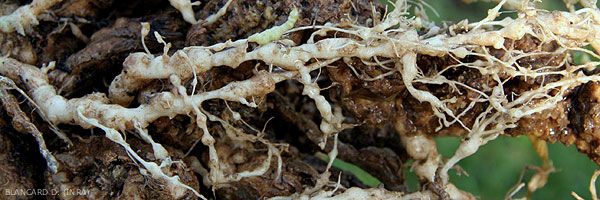
Meloidogyne Goldi 1877
Root-knot nematodes,
,
- Classification: Animalia, Nematoda, Adenophorea, Tylenchida, MELOIDOGYNIDAE
- English name: Root-knot nematodes
- English name: Root-knot nematodes
Root-knot nematodes were discovered in the 1850s. The genus Meloidogyne comprises about a hundred species: they are extremely polyphagous sedentary endoparasites which attack cultivated Solanaceae, very sensitive, like many other vegetables. Among the species reported on tomato, let us mention Meloidogyne incognita (Kofoid & White) Chitwood (the most widespread species), Meloidogyne arenaria (Neal) Chitwood, Meloidogyne javanic a (Treub) Chitwood and Meloidogyne hapla Chitwood (more northern species). Other species have been reported more occasionally: Meloidogyne chitwoodi Golden et al., Meloidogyne floridensis Handoo, Meloidogyne ethiopica Whitehaed, Meloidogyne acronea Coetzee, Meloidogyne mino r Karsen, Meloidogyne mayaguensis Rammah & Hirschmann . This last species, of rather recent discovery, has been described on the American continent and in Africa .
Natural or “selected” isolates, capable of overcoming the resistance conferred by the “ gene Mi ” , have been identified in M. incognita, M. arenaria and M. javanica , we will come back to them later. It should be noted that several races described in the literature are established on the basis of the behavior of several species of Meloidogyne on a range of international differential hosts. It should be noted that these races have no connection with any virulence towards the " gene Mi " or other genes for resistance to root knot nematodes mentioned later. For example, 4 races have been described in M. incognita .
Root-knot nematodes are widespread worldwide and affect several thousand plants. As we have previously argued, several species are found on tomato, a nightshade which seems to be a universal host for these microscopic worms. The Meloidogyne are by far the most common and most damaging on this plant; the sometimes considerable damage they cause has been reported in many countries, both in field crops and under cover. In the latter, the losses recorded are often more consequent because of the impossibility of carrying out rotations.
Given the polyphagia of these nematodes on vegetable crops, they are found in France in the soils of many farms, particularly in the past market gardening. Their damage is serious on farms where the management of crop rotations and the sanitary quality of the soil are not good. The disappearance of methyl bromide and the absence of truly effective alternative methods are gradually leading to an increase in the importance of nematode problems on vegetable crops.
Natural or “selected” isolates, capable of overcoming the resistance conferred by the “ gene Mi ” , have been identified in M. incognita, M. arenaria and M. javanica , we will come back to them later. It should be noted that several races described in the literature are established on the basis of the behavior of several species of Meloidogyne on a range of international differential hosts. It should be noted that these races have no connection with any virulence towards the " gene Mi " or other genes for resistance to root knot nematodes mentioned later. For example, 4 races have been described in M. incognita .
Root-knot nematodes are widespread worldwide and affect several thousand plants. As we have previously argued, several species are found on tomato, a nightshade which seems to be a universal host for these microscopic worms. The Meloidogyne are by far the most common and most damaging on this plant; the sometimes considerable damage they cause has been reported in many countries, both in field crops and under cover. In the latter, the losses recorded are often more consequent because of the impossibility of carrying out rotations.
Given the polyphagia of these nematodes on vegetable crops, they are found in France in the soils of many farms, particularly in the past market gardening. Their damage is serious on farms where the management of crop rotations and the sanitary quality of the soil are not good. The disappearance of methyl bromide and the absence of truly effective alternative methods are gradually leading to an increase in the importance of nematode problems on vegetable crops.





